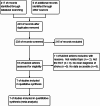Does noninvasive cerebellar stimulation improve the balance and walking function of patients with stroke: A meta-analysis of randomized controlled trials
- PMID: 36086722
- PMCID: PMC10980459
- DOI: 10.1097/MD.0000000000030302
Does noninvasive cerebellar stimulation improve the balance and walking function of patients with stroke: A meta-analysis of randomized controlled trials
Abstract
Objectives: Investigating the efficacy and safety of noninvasive cerebellar stimulation in improving the balance and walking function of patients with stroke.
Methods: We searched 7 databases for randomized controlled trials (RCTs) related to noninvasive cerebellar stimulation in the treatment of stroke. The Berg Balance Scale (BBS), 6-minute walk test (6MWT), and Barthel Index (BI) were used as the outcome indexes to evaluate balance, walking and activities of daily living (ADL). The quality of the research was evaluated using the Cochrane Risk of Bias Tool. A meta-analysis was performed to evaluate the difference between the noninvasive cerebellar stimulation and control groups. Heterogeneity tests were performed to assess differences in treatment effects across noninvasive cerebellar stimulation modalities. A sensitivity analysis was performed to evaluate the robustness of the results.
Results: Seven studies were included, and 5 articles (71.43%) were rated as having a low risk of bias. Among the primary outcome indicators, 4 of the 7 articles were combined into the fixed effect model (I2 = 38%, P = .18). Compared with the control group, noninvasive cerebellar stimulation improved the BBS score, and the difference was statistically significant (mean difference [MD]: 3.00, 95% confidence interval [CI]: 1.10-5.40, P = .03); the sensitivity analysis showed that the statistical model was still stable after sequentially eliminating each article. Compared with the control group, noninvasive cerebellar stimulation improved the 6MWT results of patients with stroke (MD: 25.29, 95% CI: 4.86-45.73, P = .02). However, noninvasive cerebellar stimulation did not improve the BI (MD: 15.61, 95% CI: -7.91 to 39.13, P = .19). No safety problems or adverse reactions to noninvasive cerebellar stimulation were observed.
Conclusions: Noninvasive cerebellar stimulation improves balance and walking function of patients with stroke, but its effect on ADL is uncertain. Due to the methodological weaknesses in the included trials, more RCTs are needed to confirm our conclusions.
Copyright © 2022 the Author(s). Published by Wolters Kluwer Health, Inc.
Conflict of interest statement
The authors declare no conflicts of interest for this study.
Figures






Similar articles
-
Cerebellar transcranial magnetic stimulation for improving balance capacity and activity of daily living in stroke patients: a systematic review and meta-analysis.BMC Neurol. 2024 Jun 15;24(1):205. doi: 10.1186/s12883-024-03720-1. BMC Neurol. 2024. PMID: 38879485 Free PMC article.
-
Does noninvasive brain stimulation combined with other therapies improve upper extremity motor impairment, functional performance, and participation in activities of daily living after stroke? A systematic review and meta-analysis of randomized controlled trial.Top Stroke Rehabil. 2023 Apr;30(3):213-234. doi: 10.1080/10749357.2022.2026278. Epub 2022 Feb 3. Top Stroke Rehabil. 2023. PMID: 35112659
-
Short term effects of anodal cerebellar vs. anodal cerebral transcranial direct current stimulation in stroke patients, a randomized control trial.Front Neurosci. 2022 Nov 24;16:1035558. doi: 10.3389/fnins.2022.1035558. eCollection 2022. Front Neurosci. 2022. PMID: 36507323 Free PMC article.
-
Effects of hydrokinesitherapy on balance and walking ability in stroke survivors: a systematic review and meta-analysis of randomized controlled studies.Eur Rev Aging Phys Act. 2019 Nov 13;16:21. doi: 10.1186/s11556-019-0227-0. eCollection 2019. Eur Rev Aging Phys Act. 2019. PMID: 31754406 Free PMC article.
-
Ankle-foot orthoses and continuous functional electrical stimulation improve walking speed after stroke: a systematic review and meta-analyses of randomized controlled trials.Physiotherapy. 2020 Dec;109:43-53. doi: 10.1016/j.physio.2020.08.002. Epub 2020 Aug 20. Physiotherapy. 2020. PMID: 33120054
Cited by
-
Effects of Cerebellar Transcranial Magnetic Stimulation on the Motor Function of Patients With Stroke: A Systematic Review and Meta-Analysis.Brain Behav. 2025 Apr;15(4):e70471. doi: 10.1002/brb3.70471. Brain Behav. 2025. PMID: 40249071 Free PMC article.
-
Effect of theta burst stimulation on lower extremity motor function improvement and balance recovery in patients with stroke: A systematic review and meta-analysis of randomized controlled trials.Medicine (Baltimore). 2024 Nov 1;103(44):e40098. doi: 10.1097/MD.0000000000040098. Medicine (Baltimore). 2024. PMID: 39495989 Free PMC article.
-
Cerebellar transcranial magnetic stimulation for improving balance capacity and activity of daily living in stroke patients: a systematic review and meta-analysis.BMC Neurol. 2024 Jun 15;24(1):205. doi: 10.1186/s12883-024-03720-1. BMC Neurol. 2024. PMID: 38879485 Free PMC article.
References
-
- Horak FB, Diener HC. Cerebellar control of postural scaling and central set in stance. J Neurophysiol. 1994;72:479–93. - PubMed
-
- Ilg W, Synofzik M, Brötz D, et al. . Intensive coordinative training improves motor performance in degenerative cerebellar disease. Neurology. 2009;73:1823–30. - PubMed
-
- Lefaucheur JP, Aleman A, Baeken C, et al. . Evidence-based guidelines on the therapeutic use of repetitive transcranial magnetic stimulation (rTMS): an update (2014-2018). Clin Neurophysiol. 2020;131:474–528. - PubMed
-
- Chung SW, Hill AT, Rogasch NC, et al. . Use of theta-burst stimulation in changing excitability of motor cortex: a systematic review and meta-analysis. Neurosci Biobehav Rev. 2016;63:43–64. - PubMed
Publication types
MeSH terms
LinkOut - more resources
Full Text Sources
Medical

